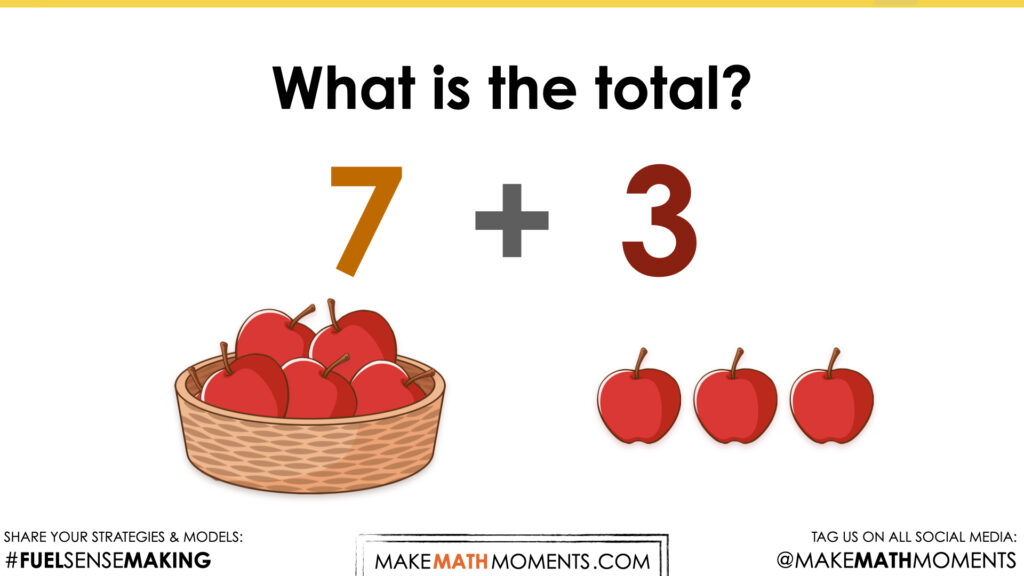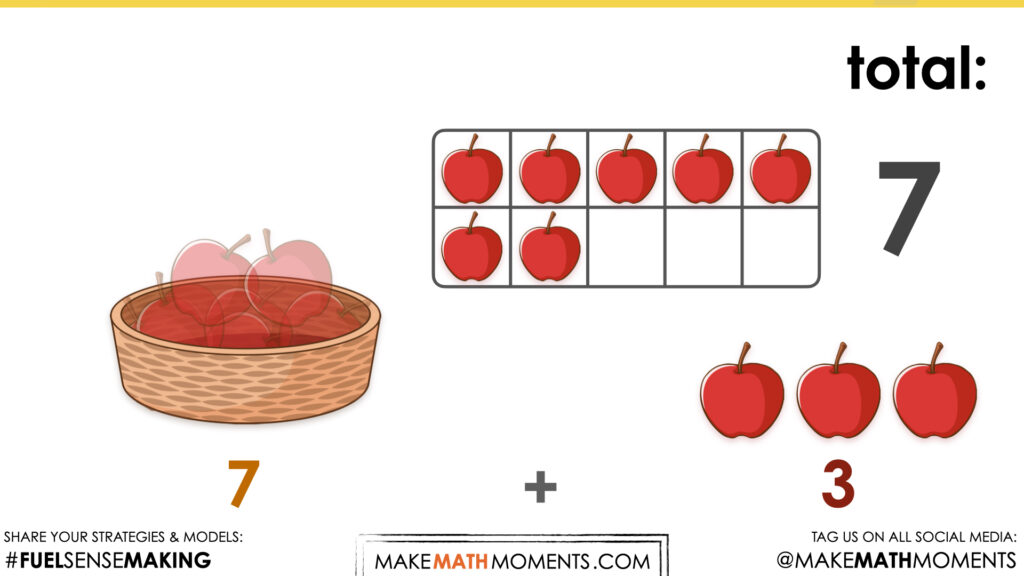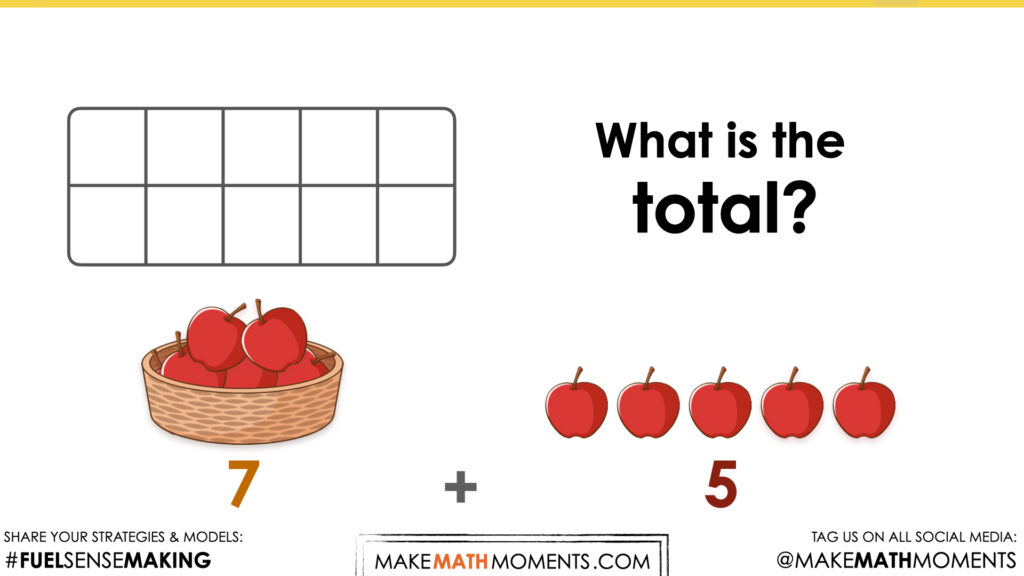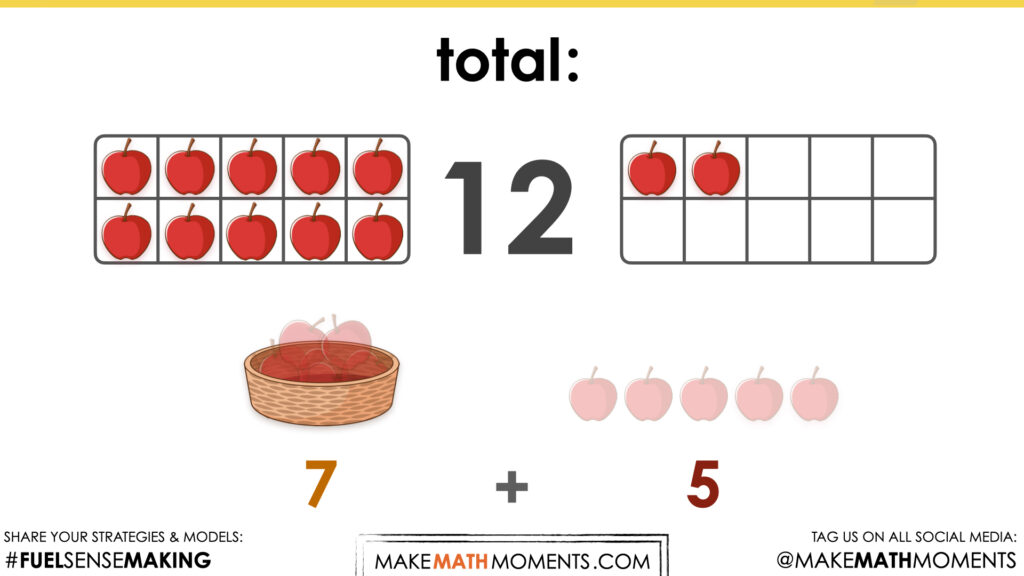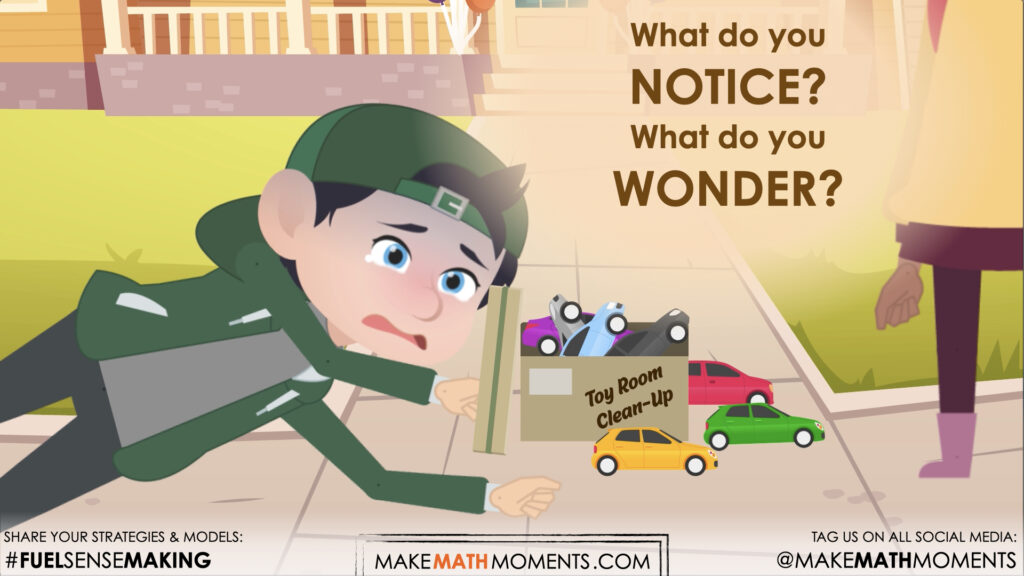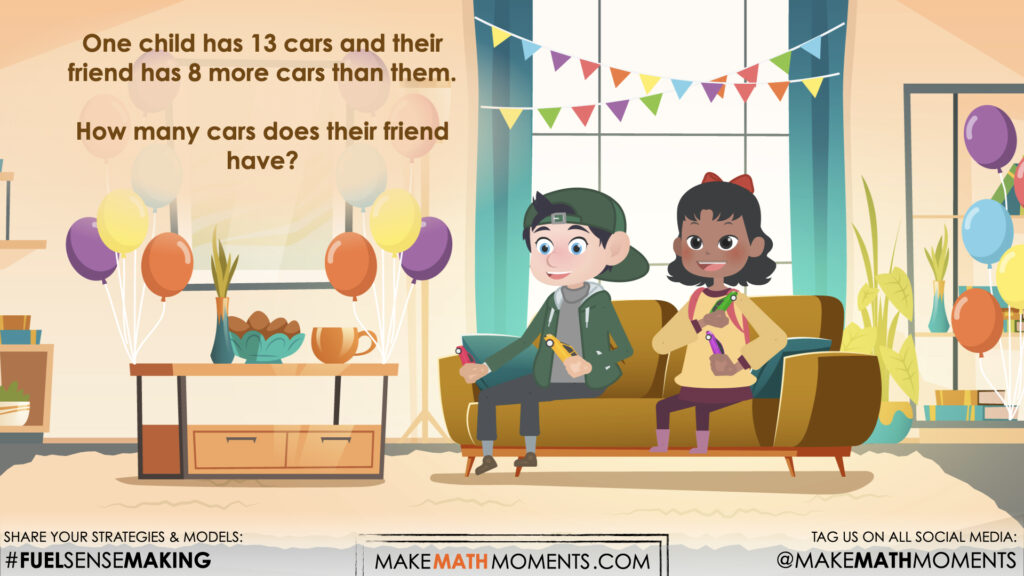COUNTING CARS [DAY 3]
ADDITION STRATEGIES: COUNTING ON
Explore addition through the strategy of counting on and the part whole model.
Intentionality
Math Talk
Visual Math Talk Prompt #1
Visual Math Talk Prompt #2
Visual Math Talk Prompt #3
Visual Math Talk Prompt #4
Visual Math Talk Prompt #5
Visual Math Talk Prompt #6
Spark Curiosity
Fuel Sensemaking
During Moves
Student Approaches
Making Connections
Reflect and Consolidation Prompts
Resources & Downloads
Educator Discussion Area
Intentionality & Unit Overview

Length of Unit: 5 Days
Access each lesson from this unit using the navigation links below
The purpose of this task is to continue the key ideas from earlier in the unit and explore another addition structure known as compare with a larger quantity unknown.
In this task, students will explore a new situation (Compare: Quantity unknown. This situation will still lend itself to the strategy of counting on. Big ideas related to this task:
- Addition names the whole in terms of the parts: when the parts of a set are known we call it addition
- Addition can be used in action situations (join and separate) and static situations (part part whole)
- Number relationships provide the foundation for strategies to help students remember basic facts
- Different addition situations will elicit different strategies
- Ability of students to visualize, interpret and solve word problems
Models can be used to connect concrete to abstract
Math Talk
This string is created to keep “counting on” still accessible but also provides the opportunity to explore counting from various points.
A numberline* (concrete or open) is particularly helpful to demonstrate this. Show the students how they can decompose one of the addends to make it easier to count on.
Facilitator Note: It is common for a student to “re-count” the number from the question when they are counting on. A concrete number line may help show that we are starting at a number and counting the spaces until the next number. Example (7 + 3= The student will count 7, 8, 9 thinking the answer is 9 but in reality we need to start at 7 and count 3 more spaces to make our answer 10)

Concrete number lines are useful at a variety of grade levels as they show the underlying quantities. For example, in this number line there are actually 20 boxes. It might be helpful to build a numberline with students to demonstrate the quantity. This could be done with blocks or cubes. This will provide students the opportunity to use the numberline as a way to count the objects/spaces.
With more abstract number lines, many of our students do not see the underlying quantities. They don’t realize the dots or lines on a number line actually indicate the end of a unit. This carries over to how students use rulers too.
Present the following through the visual number strings pictures:
String #1
7 + 3
7 + 5
Login/Join to access the entire Teacher Guide, downloadable slide decks and printable handouts for this lesson and all problem based units.
Visual Math Talk Prompt #1
Play the video of the following visual number string prompt.
The visual of the apples in a basket used in this number talk is purposeful as it does not give the students the opportunity to count the initial 7 apples. As with the number talks in Day 2, the students should be prompted to “out 7 in their head” so that it is not recounted. To really push the counting on strategy, 7 is going to be kept whole and 3 more are counted on.
The ten frame is used in the reveal portion as another visual tool to show how to make 7.
In the final reveal, 3 more apples are counted on using the ten frame. Now there is a full ten frame. If students have exposure to the ten frame before, some may recognize that a full ten frame means 10, it does not need to be recounted. It can be trusted that a full ten frame will alway mean 10.
Visual Math Talk Prompt #2
Play the video of the following visual number string prompt.
Similar to the first prompt, students can be encouraged to use the counting on strategy by keeping 7 whole and counting on 5 more. The numbers in this prompt are chosen purposefully as the result is more than 10. Students who want to model 7 on their fingers and try to count on 5 more will “run out of fingers”. By presenting a situation where a new strategy will be more efficient, it encourages students to try something that they may not have before. For example, in the first prompt, a student could easily count 7 on their fingers and then count 3 more. It may present as if they are counting on but since they are modelling the initial number of 7, this is still in the early stages of counting all.
A second ten frame was needed as the result went over 10. In this reveal, students may also share how they used a different tool, such as their fingers, to track the 5 as they counted on.
Visual Math Talk Prompt #3
Login/Join to access the entire Teacher Guide, downloadable slide decks and printable handouts for this lesson and all problem based units.
Visual Math Talk Prompt #4
Login/Join to access the entire Teacher Guide, downloadable slide decks and printable handouts for this lesson and all problem based units.
Visual Math Talk Prompt #5
Login/Join to access the entire Teacher Guide, downloadable slide decks and printable handouts for this lesson and all problem based units.
Visual Math Talk Prompt #6
Login/Join to access the entire Teacher Guide, downloadable slide decks and printable handouts for this lesson and all problem based units.
Spark Curiosity
What Do You Notice? What Do You Wonder?
Show students the following video that shows people arriving for the birthday party. One party guest brought more cars. Students will wonder and notice how many cars are in the package.
Then, ask students:
What do you notice?
What do you wonder?
Ask the students to share some of their notice and wonderings with their neighbours for about 60 seconds.
Finally, allow students to share with the entire group. Be sure to write down these noticings and wonderings on the blackboard/whiteboard, chart paper, or some other means to ensure students know that their voice is acknowledged and appreciated.
Some of the noticing and wondering that may come up includes:
- Who are those people?
- What gifts did they bring?
- What kind of party are they doing to?
- Is that a car sticking out of the box?
- Are there lots of cars in the box?
- Why did they use an old box to bring presents to a party?
- There are 4 people coming to the party
- Is that a family?
- I think there are 10 cars still in the box
Fuel Sense-making
Crafting A Productive Struggle: Prompt
Building on the Context Through Storytelling
Continue developing the context by sharing the following video with students and verbally highlighting details leveraging the following script that builds on the story from day 1:
The birthday party has ended and cousins have arrived to celebrate. They have cleaned out their toy room and found some more toy cars.
Prompt:
The cousin has 8 more cards than you. You have 13 cars. How many cars does the cousin have?
Facilitators Note: This situation is a Compare: Quantity unknown. This situation will encourage students to have to hold the amount of cars after the birthday in their head and count on the 8 more cars that were brought to the birthday party.
During Moves
While Students Are Productively Struggling…
Login/Join to access the entire Teacher Guide, downloadable slide decks and printable handouts for this lesson and all problem based units.
Student Approaches
Student Approach #1: Direct Modelling and Counting All
Login/Join to access the entire Teacher Guide, downloadable slide decks and printable handouts for this lesson and all problem based units.
Student Approach #2: Counting On with Comparison
Login/Join to access the entire Teacher Guide, downloadable slide decks and printable handouts for this lesson and all problem based units.
Student Approach #3: Getting to a decade number using a number line
Login/Join to access the entire Teacher Guide, downloadable slide decks and printable handouts for this lesson and all problem based units.
Making Connections
Login/Join to access the Teacher Guide, downloadable slide decks and printable handouts for this lesson and all problem-based units.
Reflect and Consolidation Prompts
Reflect
Login/Join to access the Teacher Guide, downloadable slide decks and printable handouts for this lesson and all problem-based units.
While Students Are Practicing…
Login/Join to access the Teacher Guide, downloadable slide decks and printable handouts for this lesson and all problem-based units.
Consolidation Prompt #1:
Login/Join to access the entire Teacher Guide, downloadable slide decks and printable handouts for this lesson and all problem based units.
Consolidation Prompt #2:
Login/Join to access the entire Teacher Guide, downloadable slide decks and printable handouts for this lesson and all problem based units.
Consolidation Prompt #3:
Login/Join to access the entire Teacher Guide, downloadable slide decks and printable handouts for this lesson and all problem based units.
Consolidation Prompt #4:
Login/Join to access the entire Teacher Guide, downloadable slide decks and printable handouts for this lesson and all problem based units.
Consolidation Prompt #5:
Login/Join to access the entire Teacher Guide, downloadable slide decks and printable handouts for this lesson and all problem based units.
We suggest collecting this reflection as an additional opportunity to engage in the formative assessment process to inform next steps for individual students as well as how the whole class will proceed.
Resources & Downloads
Login/Join to access the entire Teacher Guide, downloadable slide decks and printable handouts for this lesson and all problem based units.
Educator Discussion Area
Login/Join to access the entire Teacher Guide, downloadable slide decks and printable handouts for this lesson and all problem based units.
Explore Our 60+ Problem Based Units
This Make Math Moments Lesson was designed to spark curiosity for a multi-day unit of study with built in purposeful practice, number talks and extensions to elicit and emerge strategies and mathematical models.
Dig into our other units of study and view by concept continuum, grade or topic!


